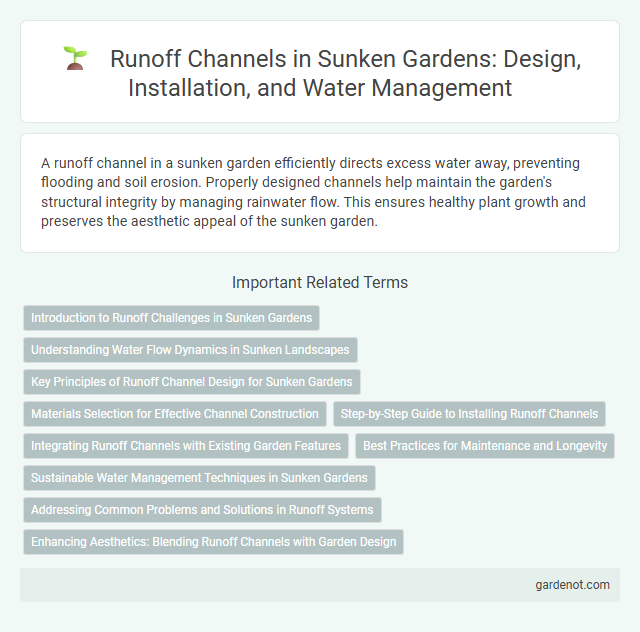A runoff channel in a sunken garden efficiently directs excess water away, preventing flooding and soil erosion. Properly designed channels help maintain the garden's structural integrity by managing rainwater flow. This ensures healthy plant growth and preserves the aesthetic appeal of the sunken garden.
Introduction to Runoff Challenges in Sunken Gardens
Runoff in sunken gardens presents unique challenges due to their below-grade design, which limits natural drainage and increases water accumulation risks. Inefficient runoff channels can lead to soil erosion, plant root damage, and waterlogging, affecting garden health and stability. Properly designed runoff channels are essential to manage excess water, maintain soil integrity, and support sustainable garden ecosystems.
Understanding Water Flow Dynamics in Sunken Landscapes
Runoff channels in sunken gardens are engineered to effectively manage water flow by directing excess surface water away from the low-lying areas, preventing waterlogging and erosion. These channels facilitate the controlled movement of rainwater, optimizing soil moisture levels and maintaining the garden's ecological balance. Understanding the hydrodynamics of runoff channels is crucial for designing sustainable sunken landscapes that support healthy plant growth and reduce flood risks.
Key Principles of Runoff Channel Design for Sunken Gardens
Runoff channel design in sunken gardens prioritizes efficient water flow management to prevent soil erosion and waterlogging. Key principles include ensuring proper gradient slope, typically between 1-3%, to facilitate controlled water movement without causing damage. Incorporating permeable materials and vegetation buffers enhances infiltration and reduces surface runoff, promoting sustainable garden health.
Materials Selection for Effective Channel Construction
Selecting durable materials such as reinforced concrete or high-density polyethylene (HDPE) ensures effective runoff channel construction in a sunken garden, balancing strength and water resistance. Porous materials like permeable pavers or gravel facilitate natural infiltration while preventing soil erosion and maintaining structural integrity. Proper material choice reduces maintenance needs and enhances the channel's longevity, optimizing water management in the landscape design.
Step-by-Step Guide to Installing Runoff Channels
Installing runoff channels in a sunken garden begins with surveying the landscape to identify natural water flow paths and low points prone to pooling. Excavate trenches along these paths, ensuring a consistent slope of at least 1-2% to facilitate efficient drainage. Line trenches with geotextile fabric before placing perforated pipes or modular channel sections, then backfill with gravel and compact soil to secure the system and prevent erosion.
Integrating Runoff Channels with Existing Garden Features
Integrating runoff channels with existing garden features enhances water management while maintaining aesthetic harmony in sunken gardens. These channels can be seamlessly incorporated alongside pathways, flower beds, and retaining walls to efficiently guide excess water away without disrupting the landscape design. Utilizing permeable materials and natural contours further supports sustainable drainage and complements the garden's visual appeal.
Best Practices for Maintenance and Longevity
Regularly clearing debris from runoff channels in sunken gardens prevents blockages and ensures efficient water drainage, protecting plant roots from waterlogging. Inspecting channel linings annually for cracks or erosion extends their structural integrity and minimizes soil contamination. Implementing vegetation buffers and using durable, permeable materials enhances runoff channel durability and reduces maintenance frequency.
Sustainable Water Management Techniques in Sunken Gardens
Runoff channels in sunken gardens play a critical role in sustainable water management by effectively capturing and directing rainwater to minimize soil erosion and water wastage. These channels are designed with permeable materials and natural contours to promote groundwater recharge and reduce surface runoff during heavy rainfall. Incorporating bio-retention features and native vegetation further enhances filtration and maintains the ecological balance within the sunken garden environment.
Addressing Common Problems and Solutions in Runoff Systems
Runoff channels in sunken gardens often face clogging due to accumulated debris, leading to water stagnation and plant root damage. Installing mesh grates and regularly scheduled maintenance minimize blockages, ensuring smooth water flow and preventing soil erosion. Incorporating bio-filtration methods like vegetated swales enhances water quality and supports sustainable drainage management.
Enhancing Aesthetics: Blending Runoff Channels with Garden Design
Runoff channels in sunken gardens can be seamlessly integrated using natural stone materials and curvilinear shapes that mimic organic water flow patterns, enhancing the overall aesthetics. Incorporating native plants along the channel edges softens the structural lines and promotes a harmonious connection with the surrounding landscape. This design approach not only manages water effectively but also elevates the visual appeal, creating a tranquil and cohesive garden environment.
Runoff channel Infographic

 gardenot.com
gardenot.com